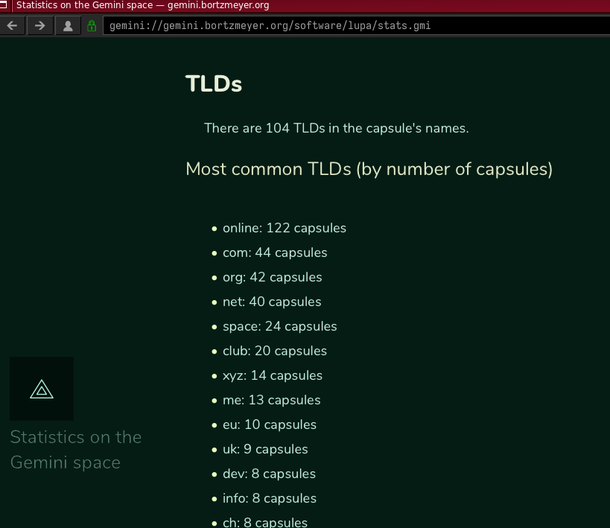Developing and running an Internet crawler
First publication of this article on 23 December 2020
I've just developed and now runs an Internet crawler. Yes, the sort of bots that goes around and gather content. But not a Web crawler. This is for Gemini. Here are a few lessons learned.
If you don't know Gemini, there is no Wikipedia page yet, so you have to go to the official site. Basically, Gemini is born from a disenchantment: the Web is technically too complicated, it is now impossible to write a browser from scratch and because of that the competition is very limited. This technical complexity does not even serve the interests of the users: it creates distractions (such as videos automatically starting), it encourages Web sites authors to focus on the look, not on the content, and it adds a lot of opportunities for surveillance. Gemini relies on a simpler protocol, with no extensions, and a simpler format.
Today, the "geminispace" is quite small. This makes easy and
reasonable to write a crawler to explore it completely. This is what
I did with the Lupa program,
which is now live on one of my machines. The goal of this crawler is
not to be used for a search engine (unlike
the crawler used in the Gemini search engine
gus.guru) but to do statistics and to survey
the geminispace. You can see the results on Gemini at the URI
gemini://gemini.bortzmeyer.org/software/lupa/stats.gmi. If
you don't have a Gemini
client yet, here is what it looks like, seen with the Lagrange client :

Now, what is the current state of the geminispace?
- 506 capsules (a Gemini capsule is a single host, a bit like a Web site) are known but Lupa could reach only 415 of them. (Gemini is quite experimental and many capsules are short-lived. Also, some links are examples and point to non-existing capsules.)
- The biggest capsule, both by the number of URIs it hosts and
by the number of bytes it contains, is
gemini.spam.works. Its content is mostly old files, some distributed on Usenet a long time ago. The second capsule by the number of bytes is my owngemini.bortzmeyer.orgbecause it contains a mirror of RFCs. - The question of certificates is touchy. Gemini suggests the use of self-signed certificates, augmented with TOFU, but not everyone agrees. Today, 17 % of the known capsules use a certificate issued by Let's Encrypt, the rest being probably self-signed.
- As it is for the Web, a same machine, with one IP address can host several "virtual hosts", several capsules. We observed 371 different IP addresses, among which 17 % use a modern protocol, IPv6. The IP address with the greatest number of "virtual hosts" is at Linode and is used for public hosting of Gemini capsules, hence its huge number of virtual hosts.
- Each capsule is identified by a domain name. Which TLD are used for these names? The most popular
is
.onlinebut this is because the same very common Gemini hosting service hosts many capsules under its name in.online, which skews the results. After that, the most popular TLDs are.com,.org,.netand.space. - 64,000 URIs are known but we got only 50,000 of them. Lupa follows the robots.txt exclusion system (more on that later) which means that some capsules or some parts of capsules cannot be crawled. Also, Lupa has a limit on how many URIs to get from a single capsule.
- The most common media types (60 % of
the total) is of course
text/geminialias "gemtext", the reference format for Gemini. Plain text comes after, with 30 %. Remember that Gemini is young and a lot of content has been produced by mirroring existing content, which is often in plain text. There are even 2 % of the URIs which are in HTML, which is surprising. Only 0.3 % are in Markdown, which should be more in the Gemini spirit than HTML. - The Gemini protocol allows servers to tag the resources with the language they're written in. The vast majority of the resources does not use this feature, maybe because they're written in English and assume it is the world's default? Among the tagged resources, the most common language is English, then French, then (but far after) Spanish.
Keep in mind that no crawler could explore everything. If there are capsules out here which are not linked from the capsules we know, they won't be retrieved.
What are the issues when running a crawler on the geminispace?
Since bots can create a serious load on some servers, a well-behaved
bot is supposed to limit itself, and to follow the preferences
expressed by the server. Unfortunately, there is no proper standard
to express these preferences. The Web uses
robots.txt but it is not really
standardized. The original
specification is very simple (may be too simple), and many
robots.txt files use one or another form of
extensions, such as the Allow: directive or
globbing. (IETF is currently trying to
standardize
robots.txt.) Because of that, you can never be sure that your
robots.txt will be interpreted as you
want. This is even worse in the geminispace where it is not clear or
specified if robots.txt apply and, if so, which
variant.
Another big problem when running a bot is the variety of network
problems you can encounter. The simplest case is when a server
replies with some Gemini error code (51 for "resource not found",
the equivalent of the famous HTTP 404) or when it rejects Gemini
connections right away (TCP RST for
instance). But many servers react in much stranger ways: timeout
when connecting (no response, not even a rejection), accepting the
TCP connection but no response to the start of the TLS negotiation,
accepting the TLS session but no response afterwards to the Gemini
request, etc. A lot of network operations can leave your bot stuck
forever, or make it run in an endless loop (for instance
never-ending redirections). It is very important to use defensive
programming and to plan for the worst. And to set a limit to
everything (size of the resources, number of resources per capsule,
etc). It is a general rule of programming that a simple
implementation which does 90 % of the job will be done quickly (may
be 10 % of the total time of the project), but a real implementation
able to handle 100 % of the job will take much longer. This is even
more so when managing a crawler.
Version PDF de cette page (mais vous pouvez aussi imprimer depuis votre navigateur, il y a une feuille de style prévue pour cela)
Source XML de cette page (cette page est distribuée sous les termes de la licence GFDL)
